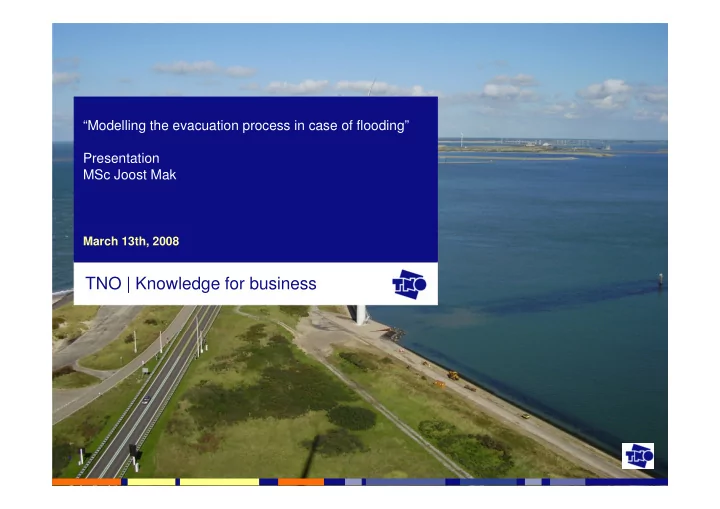

“Modelling the evacuation process in case of flooding” Presentation MSc Joost Mak March 13th, 2008 TNO | Knowledge for business 1
2
Table of Contents • Introduction • Traffic assignment model Indy • Modelling evacuations with Indy • Optimisation of the evacuation process • Conclusion 3
Introduction (1) • Econometrics Logistics and Operations Research (2001-2008) • TNO Mobility and Logistics (2006-now) � Team Intelligent Transport Systems (ITS) 4
Introduction (2) FLOODsite project � European project on floodings (predicting, preventing, evacuation) • Research questions � How to apply Indy to evacuation modelling? � How to optimise the evacuation process even further by using a method from the Operation Research? 5
Evacuations: why use models? Expected problems: • Lots of people on the road at same time • Capacity problems of road structure • Short prediction time of flooding � less time for evacuation • Good evacuation plan necessary Traffic models provide insight in total evacuation time and progress of the evacuation process 6
The model Indy • Realistic simulation of traffic over a road network • Indy = macroscopic dynamic traffic assignment model � Macroscopic (traffic flows) � Dynamic (travel time = traffic dependant) � Assigning traffic to network � no better route possible for each individual road user • Indy provides advanced traffic jam modelling 7
How to apply Indy to the evacuation process • Necessary information for modelling evacuations: � Area at risk with the possible exits 8
The case area with possible exits * * * * 9
How to apply Indy to the evacuation process • What do we need when modelling evacuation? � Area at risk with the possible exits � Departure times of people (departure profile) 10
Examples departure profiles 100 90 percentage of people left from their homes 80 70 60 50 40 30 20 10 0 0 2 4 6 8 10 12 14 16 time in hours 11
How to apply Indy to the evacuation process • What do we need when modelling evacuation? � Area at risk with the possible exits � Departure times of people (departure profile) � Zones with number of inhabitants � Assignment of people to various exits 12
Assignment people to exits 13
How to apply Indy to the evacuation process • What do we need when modelling evacuation? � Area at risk with the possible exits � Departure times of people (departure profile) � Zones with number of inhabitants � Assignment of people to various exits � Some assumptions concerning the evacuation process • Various scenarios simulated (different exits, departure profiles, exit assignments) 14
Results Indy simulations • Total evacuation time varies between 22 and 40 hours � Linear departure profile � Optimal assignment to exits • Evacuation not optimal � a lot of traffic jams apparent 15
Traffic flows at time instant during simulation 16
Optimisation evacuation process (1) Maximum flow problem Flow network G ( , V E ) with vertex set V and edge set E, and = source s and sink t = � | f | f v t ( , ) Maximize flow v V ∈ Subject to: f v w ( , ) c v w ( , ) for all (capacity constraint), ( , v w ) VxV ≤ ∈ ( , ) ( , ) f v w f w v for all (anti-symmetry constraint), = − ( , ) v w VxV ∈ � f u v ( , ) 0 for all v V { , } s t (flow conservation constraint) = ∈ − u V ∈ 17
Optimisation evacuation process (2) • Solving it with the push/re-label algorithm of Goldberg & Tarjan • Pushing flow through network until no more can get through • Projected to evacuation modelling: � Flow network � Road network � Source � Zone � Sink � Exit point • Idea: Better use of the available road network by optimising the departure times and assignment of people over the exits 18
Step-wise application max-flow (1) 1. Choose a time-interval in which the sub (max flow) problems per exits are to be solved. 2. Choose the exit point with the nearest non-empty zone still available based on the shortest path distances. 3. Solve the max-flow problem for the combination of the chosen exit point and his nearest non-empty zone. 19
Step-wise application max-flow (2) 4. Update capacities of the links in the network, and solve the max-flow problem for the next nearest non-empty zone/exit combination. 20
Step-wise application max-flow (3) 5. Repeat step 4 until no more flow is found to all the exits for this time-step. 6. Update the time with the chosen time interval and repeat the process again (now with the original network capacities) until no demand is left in any zone. All inhabitants are now given a time interval in which they are supposed to leave. Idea of starting with nearest zones: Try to minimize conflicting traffic flows over time 21
Conclusions & recommendations (1) • Better result: 14,5 hour (compared to 22 hours first) but…. • Disadvantages maximum flow application � Long unnecessary routes � No simulation of traffic flows therefore… • Indy run with new input: 18% better evacuation time 22
Conclusions & recommendations (2) • Doubts about all models: � No modelling of human behaviour � Refusing advises � Panic situations � Etc. � Results difficult (impossible?) to achieve � Very individualised • Future scenario: tracing people via GPS and (real time) providing evacuation routes via in-car navigation systems 23
“Modelling the evacuation process in case of flooding” Presentation MSc Joost Mak March 13 th , 2008 TNO | Knowledge for business 24
Recommend
More recommend